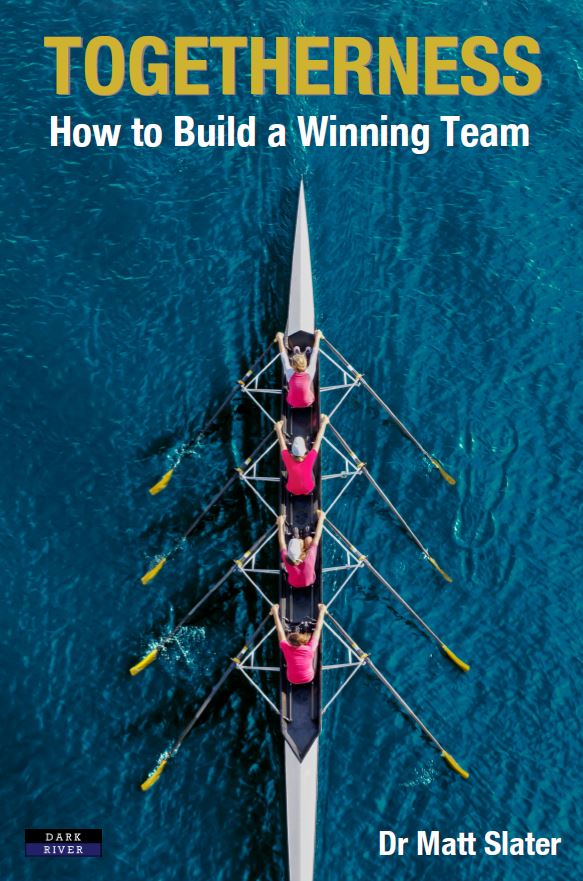An excerpt from Togetherness: How to Build a Winning Team, by Dr Matt Slater:
* * * * *
Activities to Reflect
Now that we have introduced reflection from a togetherness perspective, we move onto activities that you can complete with your team.
Identity Mapping #1 – group networks
The identity mapping exercise will help you to understand the group memberships that are important to you and members of your team.
This activity has been used with university students, clinical populations, in elite sport, [i],[ii] and in the Royal Air Force. It asks individuals to write down the name of each social group that they are a member of, to generate a map. Typical groups include family, friends, sport groups, hobbies…
At this point, we aim to capture the athletes as people, rather than focussing solely on their sports team group membership (typically, this will be one of the groups that athletes note down).
To help us further illustrate the importance of understanding one another’s group memberships, we turn to a fascinating story told by Rio Ferdinand on BT Sport in 2017. Alongside Steven Gerrard and Frank Lampard, the theme of the discussion centred on “Why did the England golden generation fail?” This was a discussion between the three ex-England footballers, and presenter, Jake Humphrey, on why an England football team littered with star players of their time serially underperformed and underachieved under numerous managers.
Ferdinand said:
“We were nicknamed the golden generation. Expectations were huge for us, as a national team, to go out there and win something. That, there, is probably what held us back, not being able to separate out club ties and international ties.
“I wrote a chapter in my book about Frank. We grew up together at West Ham then we went our separate ways; I was at Man United, he was at Chelsea. We did everything together from 16 to 21, roomed together, travelled together, did everything together.
“When I went to Man United and he went to Chelsea, we stopped talking, never spoke about it, just stopped talking. And then I wrote this chapter at the end of my career, before it went out, out of courtesy, let me send it to you Frank, just read this and let me know if it’s OK to put in.
“He texted me back and said, ‘If I was doing a chapter on you, it would have been word for word the same’. We didn’t hate each other but I didn’t want to give him anything that he might take back to Chelsea; I didn’t like him anymore really because he played for Chelsea; he was getting his hands on a trophy that I wanted.”
From this quote, we are provided with an insight into the differences between the connections the athletes felt to their club (Manchester United/Chelsea) vs. their country. For a moment, think back to Chapter 1 where we discussed the notion that individuals are always operating within the boundaries of either their personality or one of their group memberships. In this case, when England needed the athletes to play, live, and breathe for the nation, they remained (psychologically at least) playing, living, and breathing for their clubs.
Understanding how athletes see their own group network (the groups that are important to them; e.g., Manchester United/Chelsea) is the first step to then create togetherness within the group membership that we share (e.g., England).
Having multiple positive group memberships is a strong predictor of an individual’s well-being. So, in simple terms, a fuller map that includes numerous groups that are perceived positively is good for our psychological health. And it is the individual seeing their group memberships positively that is crucial. On a project led by Wing Commander Craig White, we found that Royal Air Force personnel reported higher resilience when members of fewer groups overall, but a greater number of positive groups. So, quality over quantity matters.
Also, receiving support from other people is beneficial for well-being, but only support given by individuals within “our group” and not outsiders.

[Above] Understanding your own and your team members’ group network can be done through identity mapping.
You will now create your own identity map. Using the blank map coming up, draw a map of the significant and meaningful group memberships that you have/are part of. Examples of groups could include your sports team, other leisure groups, friendship groups, family ties, workplace groups. The crucial part is that you believe these groups are important to you. Be creative (some people prefer a bullet point list, whilst others draw their network using pictures)!
To run this identity mapping activity with your team, provide each athlete (or member of the team if you are including staff) with the sheet on the next page. Allow them ample time to complete their map (usually around 20-30 minutes). As with the Draw Togetherness activity, encourage them to be creative and make clear that everyone will share/present their picture with the rest of the team once they have all finished. Once all the team has completed their map individually, ask the team, one-by-one, to share their map with the team. You can do this as you see fit. You could arrange the seating to encourage disclosure (e.g., circular or half-moon) so that athletes can share their map whilst sat down. Another option (often more challenging for athletes) is to invite them to stand up to present to the rest of the team. Encourage the athletes to take their time and go into as much detail as they are happy to do, when telling their story.
As a team, this activity promotes:
- Understanding of one another on the team (e.g., athletes often comment that they now know the person behind the athlete).
- Conversation starters/ice-breakers for the team (e.g., following a mapping session, I remember one athlete approaching another to say “I didn’t realise that you were brought up in X”).
- Understanding of how members “see” the sports team (e.g., athletes often comment on how they realise that the sports team means a lot to everyone).
- As a shared and challenging experience, it starts to bring the team together experientially.
This first identity mapping activity feeds directly into the next mapping exercise. Read on!
Identity Mapping #1
Overview: Understanding the identities within your team is the first step for developing togetherness. Conduct the following activity with all the team.
Instructions: In the space below, draw a map of the significant and meaningful group memberships that you have/are part of. These groups may include leisure groups, sports teams, family, workplace groups – to name but a few – but they must be important to you. Be authentic and creative!
* * * * *
Download the free workbook that accompanies this book to complete this exercise by clicking here >>>
* * * * *
Identity Mapping #2 – “Who are we?”
During the first identity mapping activity with your sports team, it’s highly likely that all the individuals involved included the team as one of their significant and meaningful groups. This is a group membership that you all share (our sports team) and becomes the focus of the identity mapping #2 activity – “Who are we?”
You will now create an identity map of your sports team. This mapping exercise begins to explore the values and goals of the team, and what the sports team means to its members. Using the blank map coming up:
- State the sports team that you are part of
- Draw a map of what it means to you to be part of this team by outlining the values you associate with being part of this team. You can do this is in list form, or with pictures
Further questions to consider:
- What are we about?
- Who do I think we are?
- What is important to us?
- What makes us special and distinctive from other teams?
- What does it mean, to me, to be part of this team?
Have a go!
Based on my experience, leaders and athletes often assume the values and aspirations of their athletes and teammates. So too do outsiders – as we did in Chapter 1 where you completed a task noting down the values you believed to represent five different organisations (e.g., Apple).
The crucial point here is that we cannot assume the values and aspirations of our team. If we assume the values, we may miss completely (or misinterpret) the values that athletes or staff members actually associate with the team. Experientially, by involving the athletes and staff as part of process, we begin to develop togetherness as they feel empowered and a valuable part of developing “who we are”. Everyone is on-board!
You can run this activity with your team in the same way as the first mapping activity. Once again, provide individuals with time on their own and then bring the team together to present their ideas, one-by-one. My experience of doing this activity tells me that this act of mutually sharing (whereby all the team go through the same process to present) is powerful. Be sure to give this ample time.
There are no right or wrong answers. The idea, here, is that you are capturing exactly how your athletes see the team in terms of values. Typically, athletes report multiple values. From my experience, some examples that might be mentioned are:
- Support
- Excellence
- Innovation/creativity
- Hard work/commitment
- Friendships
- Enjoyment
Ultimately, values will be unique to the individual and to the context.
After this activity, you’ll have a greater understanding of the values that athletes/staff associate with the team. Following this activity, take in all the team members’ maps as these are the foundations on which your togetherness will be built. Type up the values that the team has noted, in a list, and keep this safe. We will return to this data in the Represent phase!
[i] Cruwys, T., Steffens, N. K., Haslam, S. A., Haslam, C., Jetten, J., & Dingle, G. (2016). Social Identity Mapping: A procedure for visual representation and assessment of subjective multiple group memberships. British Journal of Social Psychology, 55(4), 613-642
[ii] Slater, M. J., & Barker, J. B. (2019). Doing social identity leadership: The efficacy of an identity leadership programme on perceived leadership and mobilization of effort. Journal of Applied Sport Psychology, 36, 65-86. https://doi.org/10.1080/10413200.2017.1410255


